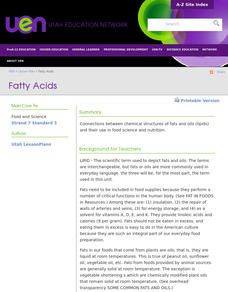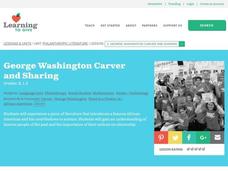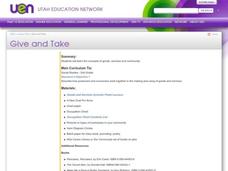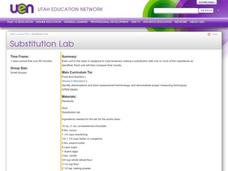Curated OER
Peanut Butter Broccoli
Fifth graders explore food production by viewing DNA presentations. In this genetic engineering lesson, 5th graders discuss the foods they typically eat at home and how many common foods are engineered in a way that can produce a bigger...
Agriculture in the Classroom
Seed Match
Using this resource, your team of green thumbs discuss why plants are a part of a healthy diet and the different ways they are used in daily life. They then observe the characteristics of different seed as they attempt to match...
Teachers' Domain
Sequencing: Princess Fairy Tales
Review with your young readers the course of events in typical fairy tales with princes, princesses, and dragons. Then read either The Paper Bag Princess by Robert Munsch or Princess Smartypants by Babette Cole to compare these two...
Curated OER
Goobers. Goobers? Goobers!
Students begin the lesson by noting the many ways in which to use peanuts. In groups, they use the internet to research the work of George Washington Carver. They discover the allergies and nutritional information of the peanut and...
Curated OER
Dizzy Gillespie
Students compare and contrast two songs by Dizzy Gillespie and identify elements of bebop. They construct a Web page about Gillespie and his music.
Curated OER
Bioplastics
Students define bioplastics and identify its uses. In this bioplastics lesson plan, students compare and contrast styrofoam to starch peanuts after careful examination. Students understand what biodegradeable means.
Curated OER
Cartoon Fractions
Students explore mathematics by viewing cartoons. In this math functions lesson, students read several "Peanut" cartoons on their worksheets as they solve fraction problems and compare them to the comic strip. Students utilize addition,...
Curated OER
Measuring Up on the Mayflower
Second graders use a meter tape to compare the length of the Mayflower to a basketball court and make homemade butter for crackers. Afterward, all students sit inside the makeshift Mayflower's dimensions and enjoy their Pilgrim butter.
Curated OER
How many seeds?
Students investigate seeds and find the difference between seeds and nuts. For this seeds and nuts lesson, students predict, then count the number of seeds in an apple. Students record and share their results. Students...
Curated OER
Baseball Geometry
Students apply various methods for finding the volume and surface area of sphere. They compare and contrast results among these mathematical methods. They work in cooperative groups to discuss their results with one another.
Curated OER
Fatty Acids
Identify the properties of fats and lipids. Compare the properties of saturated and unsaturated fatty acids Identify foods containing triglycerides and identify which foods contain saturated and unsaturated fat Discuss the function of...
Curated OER
Odor Order
In this ordering an odor from the air to the brain worksheet, students read a passage, number sentences about how odor travels from the air to the brain in sequence, and write a paragraph comparing two items that smell good and smell...
Curated OER
Calories and Nutrition
In this calories worksheet, students use a chart comparing the calories found in different food items to complete 3 short answer questions.
Curated OER
George Washington Carver and Sharing
Students research George Washington Carver. In this science instructional activity, students discuss George Washington Carver's contribution to science. Students explain how peanut butter is produced.
Curated OER
Probability
Students complete various activities for probability. In this probability lesson plan, students use coins, cubes, peanut butter and jelly, playing cards, number cubes, darts, and a Gauss Curve to study probability. Students must orally...
Curated OER
Nutrition
Students learn about good nutrition. In this biology lesson plan, students test samples of food to find out if they contain fat, test fruit juices for vitamin C and compare the vitamin C content of the juices, calculate the number of...
Curated OER
By The Pound
Students develop mathematical skills using measurement in the form of weight. They also perform calculations to find cost and strengthen estimation skills while comparing the actual price. The context for the lesson plan is in the...
Curated OER
Liquids Have Differnt Viscosities
Young scholars explore visosity of matter. They run tests of various liquid substances to observe and compare rates of flow of different substances. In addition, they relate viscosity to distance travelled by sample substances.
Curated OER
The Day an Egg Solved the Mystery of the Cell
Students conduct an experiment comparing human cells to chicken cells. In this cells lesson plan, students conduct an experiment to see how nutrition moves through cells and how to better take care of their bodies.
Curated OER
Give and Take
Second graders explore the concepts of goods, services and community. They go on a community walk, find businesses and logos within their community, read books about communities, and compare various goods and services. They pick a job...
Curated OER
Animals
First graders study the basic needs of animals and compare them to human needs. They make bird feeders using milk carton and pine cones. They review the basic needs of food, water, air, and shelter and discuss what happens when animals...
Curated OER
HAPPY SOIL, SAD SOIL
Students will be able to identify the characteristics of healthy soil and unhealthy soil.Take the class outside to an area of thick grass near trees, if available. Compare the
clothes people wear to the thin cover. Discuss the reasons...
Curated OER
The Need for Laws
Students consider the presence of authority in their lives. For this law lesson, students compare forgotten laws that function in their lives to forgotten instructions in making a peanut butter and jelly sandwich.
Curated OER
Substitution Lab
Young scholars in cooking class prepare and cook brownies, making a substitution with one or more of the ingredients as instructed. They compare their results in regard to appearance, flavor and texture. They develop an understanding of...

























